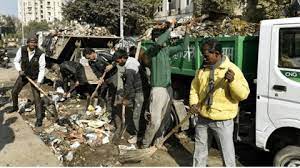Budget 2024: Analysis Reveals Challenges Faced by Sanitation Workers in India

The Prohibition of Employment as Manual Scavengers and their Rehabilitation Act of 2013 has surpassed a decade, and upon reviewing the last ten years (FY 2014-15 to FY 22-23), a budget estimate (BE) of Rs. 1273.2 crore was designated, of which only Rs. 231.2 crore was expended.
Ayanabha Banerjee
New Delhi- The interim budget, presented by Finance Minister Nirmala Sitharaman in Parliament on February 1, unveiled several noteworthy aspects, including the hidden challenges faced by sanitation workers and their community. Focusing on the allocation for Scheduled Castes (SCs) and Scheduled Tribes (STs), the National Campaign on Dalit Human Rights (NCDHR) presented research titled ‘Dalit Adivasi Budget Analysis 2024-25’, released on February 2 at the Press Club of India.
In the context of sanitation workers, it is crucial to discuss ‘The Prohibition of Employment as Manual Scavengers (PEMS) Act of 2013,’ which legally prohibits employing individuals as manual scavengers in the country. However, the analysis indicates a failure of the government to conduct a nationwide survey as mandated by the Act.
Many groups of sanitation workers are not happy with the budget. Safai Kamgar Union expressed its displeasure through an official statement which read as, “Safai Kamgar Union (SKU) criticizes the Union Interim Union Budget 2024-25 which belies the hopes and aspirations of lacs of sanitation workers across India. It should be noted that the allocations for the National Commission for Safai Karamcharis (NCSK) is an insignificant amount of just 12 crores, clearly reflecting the merely ritualistic nature of the commission without any actual role in improving the lot of sanitation workers.”
“It is roughly estimated that about 50 lac sanitation workers are employed across the country, with about 20 lacs working in hazardous conditions. The national average of life expectancy in India is 70 years, but the average life expectancy of sanitation workers is 40-45 years only. This indicates there is an urgent need to devote resources towards ensuring the health and safety of sanitation workers. But sadly, the political will to improve the living and working conditions of the sanitation workers is lacking and it has shown in the budgets of the present government. “
The research brings attention to data from the National Safai Karamchari Finance and Development Corporation (NSKFDC), identifying 58,098 individuals as manual scavengers. Despite this, only 530 districts out of 766 declared themselves as manual scavenging free, highlighting the government’s failure to conduct a comprehensive survey.
Minister of State for Social Justice and Empowerment, Ramdas Athawale, addressed the Lok Sabha, acknowledging that between 2018 and November 2023, 443 individuals lost their lives while performing sewer and septic tank cleaning duties. However, conflicting figures from organizations like Safai Karamchari Andolan report 1,760 deaths during this period.
The research poses critical questions regarding the global climate crisis exacerbating water scarcity and whether the implementation of sanitary pits and mechanization of cleaning processes can address these issues. It raises concerns about the extension of these solutions to rural areas where manual scavenging persists and explores sustainable alternatives.
Examining the allocated budget for the marginalized community, the research reveals that ‘The Prohibition of Employment as Manual Scavengers and their Rehabilitation Act of 2013’ had a total budget estimate (BE) of Rs. 1273.2 crore in the past ten years, with only Rs. 231.2 crore utilized. Similarly, the Swachh Bharat Mission – Rural had an unutilized amount of Rs. 2,318.1 crore.
There is no mention of contractual work, a subject which ails many sanitation workers. The Mooknayak reached out to Mandvi, who is an activist. Adding on to the plight of contractual workers, she said, “The situation is mirrored in the treatment of sanitation workers, particularly concerning contractualization, where the government consistently remains silent in budget allocations. This trend has persisted over the years, with demands regarding contractual work for sanitation workers routinely disregarded. This budget is no exception, as it follows the pattern of neglecting these issues and failing to prioritize them.”
Noticing a lack of oversight, the activist remarked, “There is a noticeable absence of mechanisms for monitoring and evaluating the performance of contracted work, leaving room for exploitation. This absence of oversight is deeply disappointing, especially for marginalized communities who rely on these jobs for livelihood. The budgets consistently favor the wealthy and neglect the needs of the marginalized, perpetuating societal segregation instead of addressing it.”
Analysis of NAMASTE Scheme of 2022
The NAMASTE was launched in 2022 as a Central Sector Scheme being undertaken jointly by the Ministry of Housing and Urban Affairs and the Ministry of Social Justice & Empowerment (MoSJE). It aims to eradicate unsafe sewer and septic tank cleaning practices. and replaced the previous scheme known as Schemes for the Rehabilitation of Manual Scavengers (SRMS) starting from 2022 under the Department of Social Justice & Empowerment and the Ministry of Housing and Urban Affairs.
Harish Gautam, executive member of Safai Kamgar Union stated “The apathy of the Union Government towards the mechanization of sanitation work is further evident from the amount allocated for National Action for Mechanised Sanitation Ecosystem (NAMASTE) scheme which is just a miserly 116.94 crores.” They added, “Already the amount is very low, but a clear picture is visible only by looking at the Budget Estimates and Revised Estimates of 2023-24 which are 97.41 crores and 30.06 crores respectively. It is obvious that though large amounts are shown as allocated for mechanization, in reality, miserly sums are spent for this.”
The Dalit Adivasi Budget Analysis further commented on the mechanization of the process, ignoring the humane aspects, “These schemes primarily focus on mechanizing the sanitation process and upgrading the skills of those already involved in sanitation work. However, they fail to address and acknowledge the systemic coercion of Dalits, particularly the Valmiki community, into intergenerational forced labour in cleaning.”
“Simply renaming and rebranding the community will not address the deeply ingrained discriminatory attitudes prevalent in society towards Dalits, which persistently find ways to force them into degrading work.” In 2022, it was introduced with a budget estimate of Rs. 97.4 crore for FY 2023-34.
The research drew attention in the shift of manual scavenging from a human lens to a mechanised lens, “Notably, there’s a concerning shift in framing the issue of manual scavenging predominantly as a mechanization problem rather than a human rights issue. This change in perspective poses a risk to the Dalit community, as they are no longer viewed through a human rights lens. This renamed scheme lacks the essential welfare component for those involved in manual scavenging.”
Courtesy : The Mooknayak
Note: This news piece was originally published in themooknayak.com and used purely for non-profit/non-commercial purposes exclusively for Human Righ







